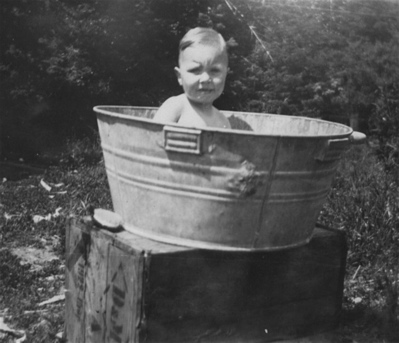The Smith family ran the farm in Sahtlam for more than 25 years, from 1920, until Thomas (Pa) died in 1946. During all those years it remained the place for extended family to gather for Sunday dinners and special events.

Circa 1925 The picture was dated by Carrie Smith based on the baby who is probably Marjorie Smith, daughter of Nels. Both main work sheds are visible. No roofing is on the far shed however it is planked with ship lap as was the exterior of the house. The woodshed behind the baby carriage covers the door to the kitchen.

Indoor Plumbing It was several years before a bathroom was added onto the house. Bath day for Edward was the ol’ galvanized wash tub set on a stump. In winter the water was heated and poured in the kitchen. Pa preferred the outhouse even after the bathroom was completed.
 Family Picnic The family made an annual outing to Victoria for a picnic at Beacon Hill. The highlight was a half fried chicken provided for each person. "Everyone getting their own half chicken was a great treat!" Carrie said. They usually made the trip in Bart's car but if Gordy was home they took two cars.
Family Picnic The family made an annual outing to Victoria for a picnic at Beacon Hill. The highlight was a half fried chicken provided for each person. "Everyone getting their own half chicken was a great treat!" Carrie said. They usually made the trip in Bart's car but if Gordy was home they took two cars.Where's the pavement? The children faced many challenges almost unheard of today. Here Edward bumps along on his trike over gravel and grass.
The Farm Tractor A farm tractor was made by modifying the back wheels of a Model T. The tires were removed and an extra wheel was welded on the outside to broaden the surface of contact. Prongs salvaged from an old bed were welded onto the spoke ends that protruded through the wheels to make the tractor treads. Les used this vehicle for farm chores. (hauling wood, moving hand cut hay, harvesting)

Chickens, turkeys and cows The farm was never without a supply of chickens and turkeys. There were usually about three cows to milk each day.
Carrie Smith talking to son David 1999:
“The best cow we ever had was called Dope!" Carrie said.
“What a crazy name for a cow. Why was she the best cow?"
“She gave lots of milk and she behaved." was the reply.
“I remember Pa squirting milk into my mouth. Maybe it was from Dope."
“Could have been, could have been.”
Cars of Yesteryear Les tells this amazing car story. He and his brother were driving over the Malahat to Victoria when they "blew the engine". They took off the oil pan, removed a piston head and discovered the trouble was a demolished bearing where the rod connects to the crankshaft. A piece of leather was cut from a shoe and pressed into the gap left by the missing bearings. They made the return trip to Victoria without further incident. "Cars were much simpler in those days," he said.










































